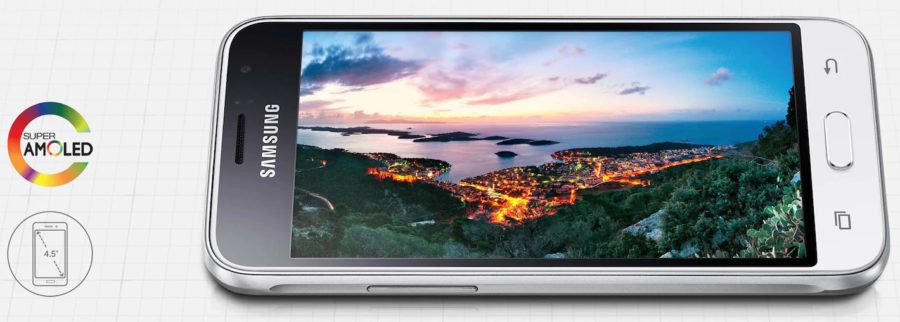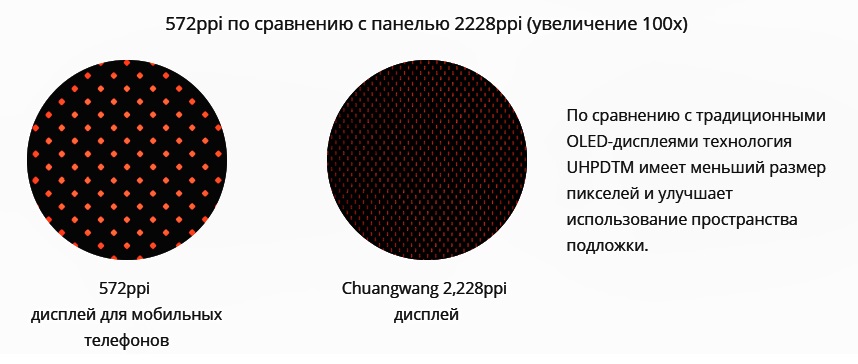The PPI race continues in 2018, or about the most advanced screens.

Manufacturing augmented reality requires the very best screens
It is difficult to overestimate the importance of the screen. When we talk about modern wearable electronics, this is the main thing that influences our first impression of a smartphone or tablet. For most users, the difference between 5-inch smartphones with a resolution of 854×480 and 1440×720 pixels is obvious. Good and bad screens have spawned new evaluations of smartphones such as 'loose font', 'torn-eyed pentail', 'ladder' and 'single pixels visible'. The elimination of these shortcomings led to an increase in screen resolution, which, in turn, spurred the development of more and more powerful chipsets. But at some point (about 4 years ago) we all considered the screen resolution of 1920 x 1080 pixels at 5 inches to be final, because already a couple of tens of centimeters from the face of the smartphone user, the 2K matrix did not give any visible advantages over FHD. And it already seemed that the developers of new ultra-high-resolution screens simply had no incentive to develop. Moreover, flexible screens suddenly appeared, first prototypes, and then commercial models, mysterious and fashionable in absentia. Has a technical thought abandoned the idea of pixel-enclosing the matrix territory, turned it in the other direction?

It turned out that not at all, and the chirping of the first signs of a new technological breakthrough in the production of displays can already be heard. But first, let's look at the objective reasons for increasing the matrix resolution, there are only two of them.
Causes:
- The virtual reality
- Placement of sensors between pixels
The virtual reality
Immediately put aside the question of virtual games, this topic is widely covered on the resource and only requires clarification of a few details. Typical modern virtual reality glasses Oculus Rift CV1 offer a screen with a resolution of 1200 x 1080 pixels with a field of view of 110 ° for each user's eye. In fact, this is a terribly low picture quality, and the 110 ° field of view raises questions, because for humans it is 180 °, albeit with a drop in the three-dimensionality and color of objects to the edge of the century. In other words, modern VR glasses are still a 'bright door to another space in pitch darkness'. It would seem that to avoid this effect, it is enough just to bring the screen matrix closer to the eye, but … But then, instead of a picture, the human eye will see pixels, many, many burning pixels.

Briefly, a successful project for virtualization of an electronic image can be expressed as follows:
The screen should be so close to the person's eye as to occupy the entire field of view, and at the same time have such a pixel density that the picture does not “crumble”.
Screens with low pixel density are the main brake on the development of VR, which could give us:
- Microsurgery, when VR lenses are put on the doctor's eyes, and a microscope camera is attached to the tip of the scalpel
- A universal soldier who sees the whole picture of the battle in 3D thanks to his colleagues and a swarm of drones
- A nano-constructor that builds a mechanism from molecules …
- Cinema with a real effect of immersion in another reality.
Placement of sensors between pixels
In the section above, we talked a little about the output device, but these days the screen is also an input device. All management of modern operating systems (except Windows) can be performed without loss of comfort by touching the screen. This is a fait accompli. Some gadget functions, such as user authentication, are already simplified with the help of fingerprint sensors, host face recognition and retinal scanners. The first commercial smartphones appeared, where these sensors are placed directly on the screen, under protective glass. However, the front-facing camera is still a hideous and misplaced black hole in the midst of overall splendor. Such 'hole phones' will appear in stores in the very near future, and a prime example is Samsung A8s.

It is logical to assume that the next step should be placing the camera (s) directly on the screen matrix. The developers are faced with two questions: reducing the size (and / or dispersing) of the photo module and decreasing the pixel to free up free space on the substrate. And while we are waiting for the appearance of a new Ibn Al-Haytham (the father of all our optics), the process of miniaturization of the pixel is going well.
Issue price
There is a lot of information on the net explaining the advantage of one or another pixel production technology. Let's simplify – there are organic LEDs (OLED / AMOLED) and transparent inorganic electrodes with molecules (LC) sandwiched between them. In both cases, the production is similar – on a silicon wafer (similar to the production of chips) or a glass substrate, future pixels are applied in thin layers-films, etched using a stencil, and the final price is determined by the demand and the amount of scrap. Since 2016, Samsung's organic AMOLED screen production technology has become in such demand, has gained such production speed that it has become cheaper than a classic LCD (TFT-IPS).

Ultra-budget Samsung Galaxy J1 (2016) with AMOLED – screen
But in the camp of manufacturers of LCD screens, despondency reigns, it seems that the very concept of technology has played a cruel joke with them, at the moment the issue of compaction of pixels by conventional methods has not been resolved. An alternative is the method of manufacturing an LCD matrix in a foundry similar to the production of chipsets, but the question of using a silicon substrate becomes inevitable, which cannot be replaced in such a production. The use of silicon makes it impossible to manufacture a flexible screen, and the price becomes astronomical. Just imagine how much a 5-inch 10nm processor could cost.
Based on these trends, a simple conclusion can be drawn – the screens of the future will be AMOLED – a matrix based on a transparent polymer.
Industry Leader
All of the above advantages in their products are promised to us by the founder and head of the Taiwanese company INT Tech, Mr. David KT Chu.

At the moment, the company is a bureau of independent developers, which, for the customer's money, develops, adapts and launches into a series of advanced devices in the field of image display based on its own patents. The real gem in the company's collection is UHPD ™ technology, which will be unveiled at CES 2019 from January 8-11. I hope that our residents will be able to reach the company's booth, but for now let's look at a few numbers:

As we can see from the table, the technology really has no analogues. It is expected that at CES 2019 we will be shown a certain AMOLED – a display close in resolution to 4K and having a pixel density of about 2200 PPI.

Using a calculator, we calculate the diagonal of such a display and get the result – 2 inches with an aspect ratio of 16: 9 and a resolution of 3840×2160 pixels.

Two inches is the diagonal of the lenses of conventional sunglasses
Conclusion
As you can see, the screen production technology does not stand still and continues to develop. Separately, I would like to note that development centers for really new technologies are increasingly appearing in the Asian region, and Silicon Valley is getting closer to becoming the Silicon Desert.

Friends, tell me, would you like to have sunglasses with 4K screens on the inside, and a smartphone Android in the temples, controlled by gestures and voice? Or a smartphone with a 5-inch screen and 24k resolution? Would you be happy with such a thing?
